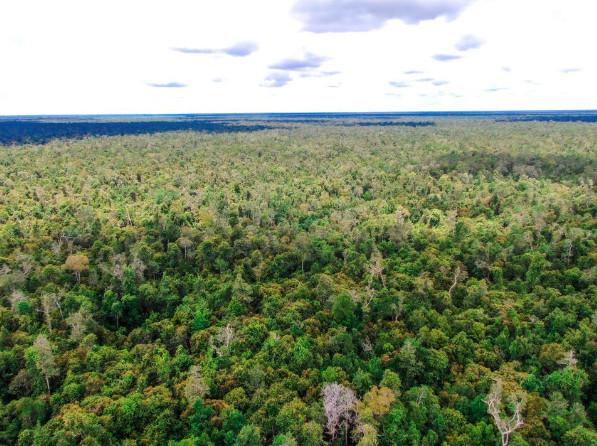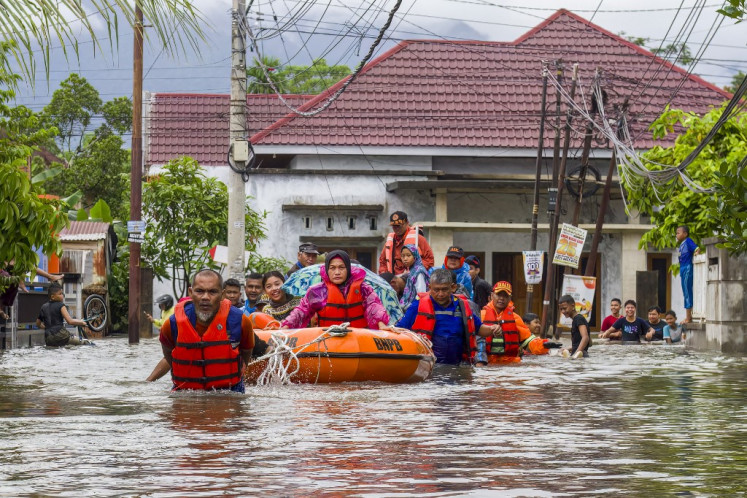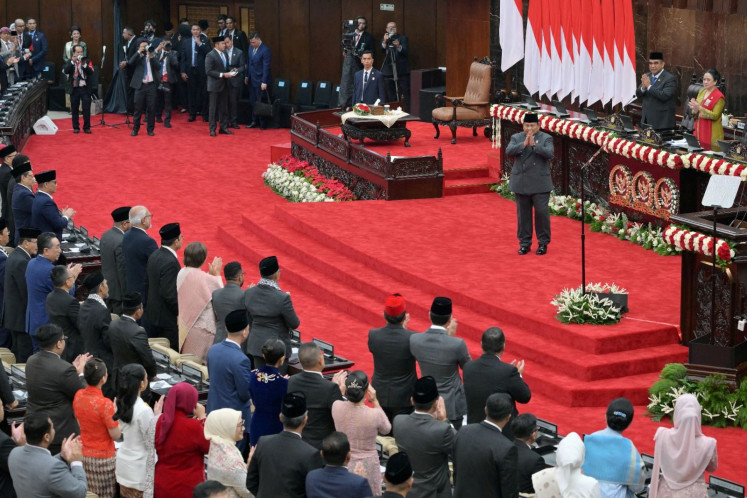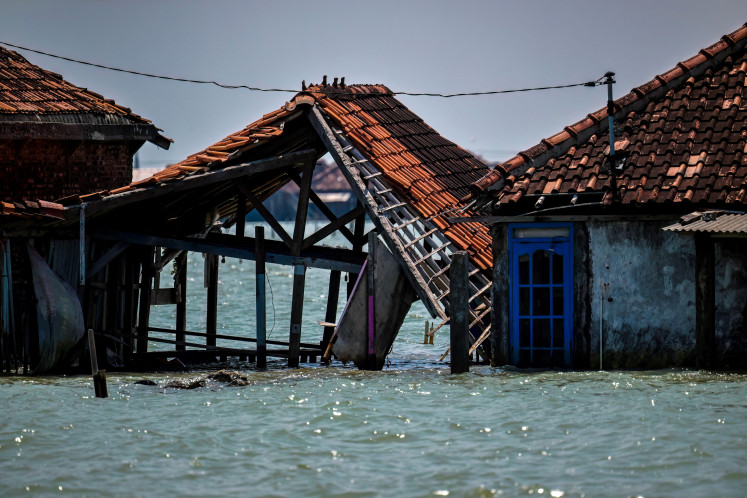Popular Reads
Top Results
Can't find what you're looking for?
View all search resultsPopular Reads
Top Results
Can't find what you're looking for?
View all search resultsInsight: Blended financing for carbon projects with greater social impact
Global collaborative endeavors to tackle climate change are once again in the limelight as COP28, which was held in Dubai, the United Arab Emirates, has just wrapped up on Dec.12. One of the most crucial items on the agenda is setting the standard for carbon credits and regulations related to Article 6 of the Paris Agreement on the Carbon Market.
Change text size
Gift Premium Articles
to Anyone
By Indra Allen and Fifiek Mulyana
Partner/Legal Leader and Junior Partner of PwC Legal Indonesia
Global collaborative endeavors to tackle climate change are once again in the limelight as COP28, which was held in Dubai, the United Arab Emirates, has just wrapped up on Dec.12. One of the most crucial items on the agenda is setting the standard for carbon credits and regulations related to Article 6 of the Paris Agreement on the Carbon Market.
Article 6 of the Paris Agreement sets out the principles for carbon markets and the establishment of international compliance carbon markets, allowing countries to trade carbon credits. This article allows countries to voluntarily cooperate with each other to achieve emissions reduction targets in their nationally determined contributions (NDCs).
Following the enforcement of the United Nations Framework Convention on Climate Change (UNFCCC) on March 21, 1994, the Paris Agreement was drafted and adopted by 196 countries during the COP21 held in Paris in 2015. The Paris Agreement, a legally binding international treaty under the UNFCCC on climate change, sets clear targets to restrict rising temperatures, limit greenhouse gas (GHG) emissions and facilitate green growth. It also allows countries to submit their NDC, which shows how each country intends to cut down carbon emissions.
This standard for carbon credits regarding Article 6 of the Paris Agreement is expected to allow some polluters to offset their emissions by investing in projects that remove carbon dioxide from the atmosphere. The negotiations on the standard kicked off in COP26 and then continued in COP27 and COP28.
With respect to Article 6, several other lingering issues need to be solved, such as the double counting which defies logic and environmental integrity. While Article 6 already establishes an accounting principle, a corresponding adjustment to prevent the occurrence of double counting does not yet exist. Thereby, Article 6 supports the carbon market as it serves as a basis for conducting the authorized transfer or sale of carbon credits from one country to another.
From our experience in dealing with existing and potential clients, as well as from observing both the domestic and global markets, the lack of established standards and regulations hinders the carbon market, especially the voluntary one.
Several carbon projects are already up and running in Indonesia. The projects that have significant social and environmental impacts include the Rimba Raya Biodiversity Project, the Katingan Mentaya Peat Conservation and Restoration Project in Central Kalimantan and the Sipansihaporas Hydroelectric Power Plant with a capacity of 50 megawatts (MW) in North Sumatra.
The Rimba Raya Biodiversity Project, which is estimated to reduce GHG emissions by 3,527,171 tonnes, engages local communities as the project partners to develop solutions. The project has contributed to the development of a community-based program to plant trees and create diversified income through native cash crops.
Meanwhile, the Katingan Mentaya Peat Conservation and Restoration Project, with an estimated GHG emission reduction of 7 billion tonnes of CO2e, has become a source of income for the surrounding community and has become a solid, innovative and transparent business. The project actively engages the local community to restore the ecosystem, with more than 75 percent of the staff employed from the local community to provide opportunities and ensure welfare.
Apart from the forest conservation initiatives, carbon projects are also related to renewable energy. For example, the Sipansihaporas Hydroelectric Power Plant in North Sumatra is estimated to reduce GHG emissions by almost 190,000 tonnes and should produce around 203 gigawatt hours (GWh) of energy per year. The electricity produced is expected to be the cornerstone of electricity supply for the community in the North Sumatra region and Aceh province.
Carbon transaction
Community engagement in carbon projects can also be seen in the Bujang Raba Area of Jambi, with KKI Warsi playing an important role in this regard.
Warsi, a non-profit organization that focuses on providing community assistance in and around the forest, specifically in Sumatra, Kalimantan and Papua, has proposed and developed a carbon community to involve local communities and also mitigate climate change.
Warsi has explored the possibility of dabbling in the voluntary carbon market since 2013. It began by ensuring there was no change in forest cover. Further it started to calculate carbon levels and prepared the Project Design Document for the Plan Vivo Program. In parallel, at the community level, aspirations were raised, and sustainable forest area management agreements were strengthened. All activities are measured by a third party through field verification and validation.
Finally, the first carbon transaction of Bujang Raba was conducted in 2018 after years of difficulties in looking for purchasers. The transaction was conducted with an institution in Sweden through Zeromission.
The money received from the transaction of 6000 tonnes in 2018 was directly earmarked to support health and education services (scholarship packages), strengthening Village Forest institutions in five villages in the Bujang Raba area as well as improving the community's economy and operational costs for area security. This scheme has continued until today and has provided plenty of benefits to the surrounding communities.
Another example of a carbon project supported by multilateral funding now under way is the BioCF Initiative in Jambi. The Directorate General of Climate Change Control at the Environment and Forestry Ministry in collaboration with the World Bank and the Jambi Provincial Government is developing REDD+ activities with the result-based payment scheme through the BioCarbon Fund Integrated Sustainable Forest Landscape (BioCF ISFL) - Jambi Sustainable Landscape Management Project (J-SLMP).
The program aims to promote reductions in GHG emissions from the land sector, reduce deforestation and forest degradation in developing countries and push for sustainable agriculture and better land use planning, policies and practices through REDD+ activities.
BioCF ISFL activities comprise three phases, namely the Preparation Phase (2019 - 2021), the Pre-Investment Phase (2021 - 2025) and the Result-Based Payment Phase (2021 - 2025).
From the corporate sector side, the carbon projects are closely related to how a company adheres to the environmental, social and governance (ESG) principles, and its ability to reap long-term benefits.
In its publication titled ‘ESG Value Creation Journey’, PwC reveals that ESG can create financial value for companies in the long-term from cost reduction, productivity, new revenue and access to finance.
Carbon projects or carbon mitigation activities fall under the environmental pillar of ESG. As such, a company that makes strides by investing in carbon projects will not only be able to preserve its value but also create further value because ESG-led investment strategies and sustainable transformation of the business model will allow it to unlock significant value creation; thereby generating new revenue streams.
Blended finance
There is no denying that funding remains a tough challenge in carrying out carbon projects under the voluntary carbon market scheme. As such, innovative breakthrough efforts should be made in this regard, with proposed blended finance to be considered.
Based on the OECD Framework, blended finance is the strategic use of development finance (including finance from concessional and non-concessional sources and private funds) for mobilization of additional finance toward sustainable development in developing countries.
In simpler terms, the instruments that blend public and private financing and that support private sector projects. Blended finance can help mitigate these risks by combining concessional or public funds with private capital. The public funds can absorb a portion of the risk, making the project more attractive to private investors.
Blended finance is a promising solution to bridge this funding gap. It unites investors from diverse sectors, including philanthropy, government and private, and brings together different risk and return profiles. Those with higher risk tolerance, such as development finance institutions (DFIs) and philanthropic funds, contribute capital to de-risk early project phases, acting as a cushion to attract further investments from those with lower risk tolerance.
Apart from infrastructure projects, blended finance has also been utilized to finance power plant projects pertaining to energy transition, which receives the government’s support. State-owned infrastructure financing company PT Sarana Multi Infrastruktur (Persero) or (“PT SMI”), which provides financing schemes for infrastructure projects, has also been focused on funding energy transition projects by collaborating with different parties. Under the Energy Transition Mechanism (ETM), PT SMI offers financing schemes, including IPP equity investment, designed for coal plant retirement projects. The funds to finance the projects that require huge cost can derive from other sources, instead of the state budget. This can also be equally applied to carbon projects in Indonesia.
Blended finance, carbon projects and social impact are highly interrelated. Blended Finance solves funding challenges, especially in high-risk projects that are in the early development stages. Carbon projects have a positive social impact.
The relatively new carbon projects are often considered high risk, which makes it difficult to secure relevant funding. By implementing blended financing schemes to fund carbon projects, a greater and more positive social impact can be achieved.
Regarding the carbon market, mobilizing private capital on a large scale will be needed to achieve climate objectives. Financial markets alone cannot do the job, but combining public and private capital offers unique advantages by reducing investment risk and attracting greater funding.
To do this, it would be advisable for countries to start by establishing an attractive investment climate and policies to incentivize private participation.
Better policies attract private investment, and in turn help meet policy objectives. Carbon pricing is considered one of the effective tools to make high emitters pay for the climate costs they impose and thereby channel private investment toward projects that emit less.
To sum up, as we navigate the complex and new landscape of the carbon market, we have seen how several factors come into play. These factors include financial innovation that is crucial to realize carbon projects and to reap the social benefits from them.
From Indonesia's transformative projects like Rimba Raya and Sipansihaporas to the impactful WARSI initiative in Jambi, it is obvious that the path forward involves aligning government incentives for financing carbon mitigation projects (through blended financing) to unlock greater social impact.
The ideas expressed here do not represent The Jakarta Post's views and policies.













